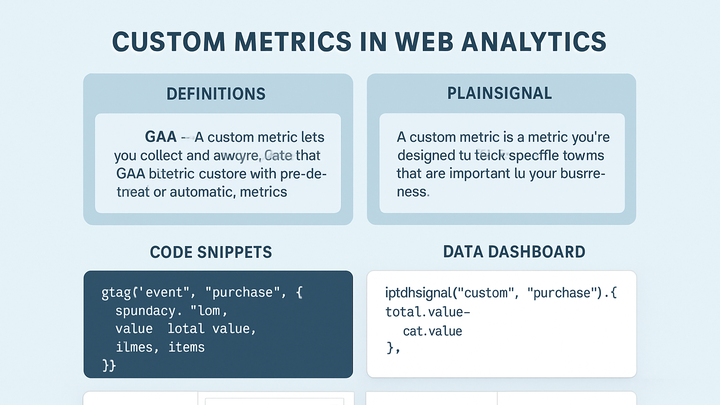Published on 2025-06-28T06:05:06Z
What Are Custom Metrics? Examples and Use Cases
Custom metrics are user-defined measurements that extend the capabilities of standard analytics data to fit unique business needs. Unlike out-of-the-box metrics such as pageviews or sessions, custom metrics let you track specialized interactions—like form submissions, video engagement, or revenue values—tailored to your KPIs. In analytics platforms like Google Analytics 4 (GA4) and PlainSignal, configuring custom metrics involves defining event parameters, registering them in the admin interface or via API, and then incorporating them into reports and dashboards. This flexibility empowers organizations to glean deeper insights, make data-driven decisions, and align analytics directly with their strategic goals. Whether you’re a marketer optimizing campaigns or a product manager monitoring feature adoption, custom metrics provide the precision and relevance modern analytics demand.
Custom metrics
Custom metrics let you track user-defined data points tailored to your business goals in analytics platforms like GA4 and PlainSignal.
Why Custom Metrics Matter
Custom metrics bridge the gap between generic analytics data and your unique business objectives. By tracking user-defined events, you can:
- Align analytics with specific KPIs
- Gain deeper insights into user behavior
- Differentiate meaningful signals from standard metrics
This tailored approach ensures analytics directly support decision-making and strategic planning.
-
Align with business goals
Custom metrics let you capture data that directly reflects your strategic objectives, such as trial-to-paid conversions or feature usage rates.
-
Gain deeper insights
Standard metrics can mask nuanced interactions. Custom metrics uncover behaviors like video completion percentage or in-app purchases.
-
Differentiate from standard metrics
While pageviews and sessions are valuable, they may not reveal the full story. Custom metrics highlight specific actions tailored to your analysis.
Creating Custom Metrics in GA4
Google Analytics 4 supports custom metrics via event parameters. You send parameters with events, register them as metrics, and then use them in reports.
-
Define event parameters
Use gtag.js or Google Tag Manager to include custom parameters when logging events.
-
Gtag.js example
gtag('event', 'purchase', { 'value': 29.99, 'currency': 'USD', 'promo_clicks': 3 }); -
Gtm configuration
In Google Tag Manager, create a user-defined variable for your custom parameter and add it to your event tag.
-
-
Register custom metric
In GA4 Admin, go to Custom Definitions → Custom Metrics, click “Create Custom Metric,” and map it to your event parameter.
-
Use metric in reports
Once registered, add your custom metric to Explorations, custom reports, and dashboards for analysis.
Implementing Custom Metrics with PlainSignal
PlainSignal is a cookie-free analytics platform that supports custom metrics via a lightweight JS snippet and API. Setup is fast and privacy-friendly.
-
Add PlainSignal tracking code
Insert the following snippet into your website’s
<head>:<link rel="preconnect" href="//eu.plainsignal.com/" crossorigin /> <script defer data-do="yourwebsitedomain.com" data-id="0GQV1xmtzQQ" data-api="//eu.plainsignal.com" src="//cdn.plainsignal.com/plainsignal-min.js"></script>-
Placement
Ensure the snippet is placed before the closing
</head>tag for optimal performance. -
Data attributes
Use
data-idto link your PlainSignal project anddata-doto specify your domain.
-
-
Define custom metrics via api
Use the PlainSignal dashboard or its API to define metrics by mapping event fields to your custom metric keys.
-
Analyze in dashboard
View and segment your custom metric data alongside standard analytics in the PlainSignal UI.
Best Practices for Custom Metrics
To ensure accuracy and actionability, follow these best practices when working with custom metrics.
-
Naming conventions
Adopt clear, consistent names that convey metric purpose, e.g.,
promo_clicksinstead of a genericclicks. -
Documentation
Maintain a living document outlining each metric’s definition, implementation details, and stakeholder owner.
-
Data validation
Regularly audit your custom metrics by cross-checking against known benchmarks or alternative data sources.
-
Monitor data volume
Avoid decisions based on low-volume metrics; ensure sufficient data is collected before analyzing trends.
